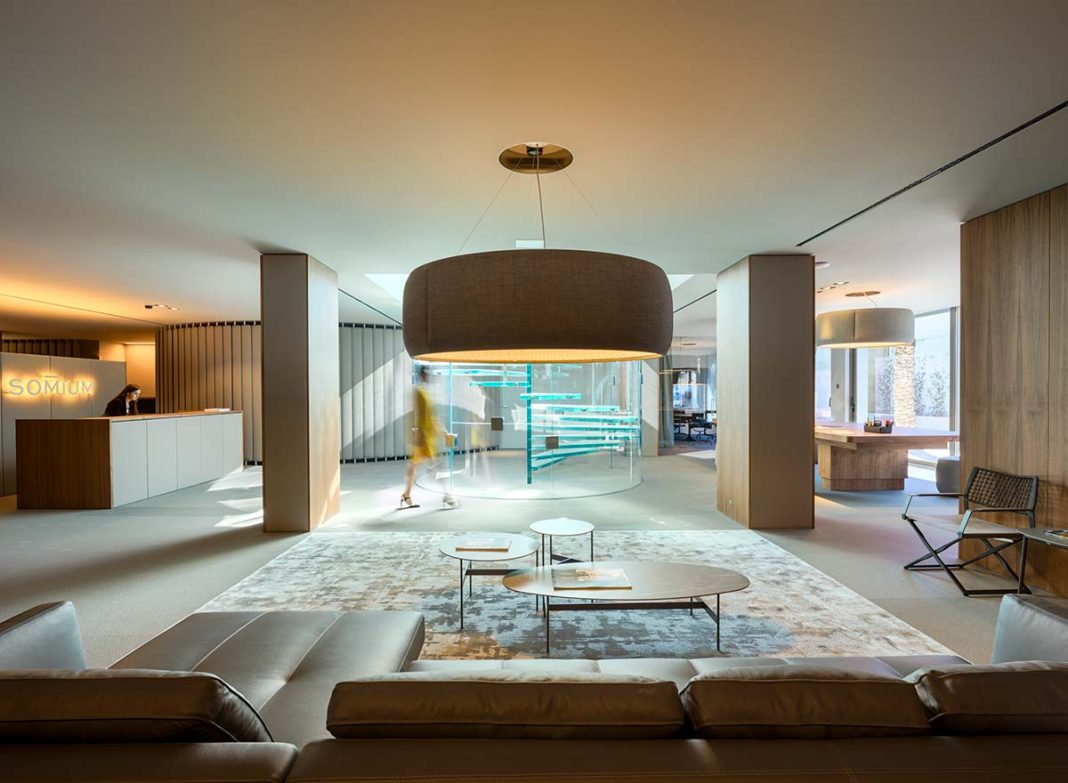It is true that brilliant ideas stem from necessity. As in the case of a production sector that is now a strong suit inside Luceplan. The need to compensate for a structural issue inside the headquarters of GL Events in Lyon, a work of architecture by Odile Decq, developing a sound-absorbing solution that would otherwise have been impossible for the ceilings, the company tried to combine lighting and acoustic comfort in a single object.
A real trailblazer, Luceplan was the first to blend research on materials, technologies and forms into a way of reducing sound transmission, while also developing an excellent light source. This was no minor challenge, starting ten years ago and requiring “design that is never limited to a single piece, but to an entire space,” says Patrizia Vicenzi, Luceplan CEO. “Specially formulated software permits testing, before and after application, of a certain number of sound-absorbing lamps, measuring the reduction of reverberation time”. One of the many steps taken by Luceplan towards the constant refinement of precise forms of expertise, including indispensable knowledge regarding technical fabrics.

Pétale by Luceplan,
Design Odile Decq

Already from the first project, Pétale, a lamp with an organic form designed by Odile Decq, the company came to grips with the use of a special elastic Lycra fabric capable of offering not only high levels of sound absorption and reduction of reverberation – especially in relation to the human voice – but also the performance required by the world of contract applications, such as flameproofing properties or resistance to UV rays and yellowing.
A thermoformed synthetic felt with sound-absorbing wadding also covers Diade, a modular architectural fixture capable of defining space and personalizing the workplace. The two wing-panels can be positioned horizontally or vertically, creating a large ceiling surface or a partition.


Diade by Luceplan,
Design Monica Armani

Silenzio by Luceplan,
Design Monica Armani

Chralottehaven Hotel
Photo © Egon Gade
The same designer, Monica Armani, has also created Silenzio, a sartorial lighting system with great décor potential, making it suitable for both public and private spaces. Here the sound-absorbing wool fabric has a grisaille look that produces an elegant texture, with the possibility of custom colors.
There is also the polyester knit fabric of Trypta, designed by Stephen Burks, a cylindrical volume that permits assembly of three acoustic panels, placed at an angle of 120°. Particularly good results, in this moment, are being achieved by a new version of Farel, the iconic dome structure by Diego Sferrazza that will be presented in June in 100% recycled fabric. “The yarns are made by a consortium that carries out a program of cleansing of the marine environment,”Patrizia Vicenzi points out, “through the gathering and recycling of plastic that pollutes seas and coastlines, generating a new high-performance fabric”.

Trypta by Luceplan, Design Stephen Burks

Farel by Luceplan,
Design Diego Sferrazza


In general terms the light source most often utilized is the LED, especially for the modular solutions, but recently Luceplan is also introducing the E27 bulb, above all with the idea of domestic use of sound-absorbing products. This innovation will soon be seen in Farel, due to increasing demand for the product in private applications. “After years of research and experience,” concludes Vicenzi, “the timing of the creations now resembles that of standard technical lighting design. The average space is about 12 months from the idea to its realization, and then to the phase of testing and certifications”.


















